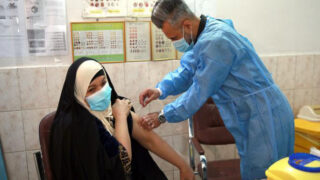
This publication has benefited from the support of the Rosa Luxemburg Foundation. This text may be reproduced in part or in full, provided the source is acknowledged.
A rise in the levels of general vulnerability, social stress, and the emigration of settled rural communities to cities that are witnessing exponential competition for services and opportunities, all point towards the severity of the combined impact of the binary of environmental disruption in Iraq: climate change and water scarcity. These two factors interact in a vicious circle comprising environmental degradation and armed conflict, according to the National Development Plan 2018-2022.
Future forecasts point to the probable widening of the impact of these factors, both of which contribute to environmental disruption in Iraq due to the catastrophic convergence of three core forces (1): violence, poverty, and climate change, whereby Iraq has come to be considered an ideal model for measuring the severity of environmental impact (2). This is all amid a lack of government response, with an absence of thought processes, circumvention tools and advance planning for risk management, along with difficulties in financing national adaptation plans from unclean energy.
Iraq is ranked 129th out of 181 countries on the ND-Gain Index, as one of the most environmentally vulnerable and fragile countries in the world, which places it at the heart of the violent effects of climate extremes and absolute water scarcity. In the next two decades, this will render Iraq an uninhabitable environment as a result of excessive temperature increases, lack of rainfall, shortage of surface water and groundwater, intensification of dust storms, drought, and desertification, all of which engender agricultural decline, a collapse of food chains, and an increase in harmful government and human activities which aim to reduce the impact of climate change.
The greatest consumer
The government assumed that increasing the share of agriculture in the country’s gross domestic product (GDP) from 4.5%, set as a target in 2015, to 5.2% in 2022 - a jump of 8.4% - might lead to reducing dependence on profits from environmentally harmful energy sources, as a mechanism to stabilise a shifting population, keeping communities in their original areas by confronting desertification and land erosion, as well as reducing warming. However, agricultural production (as part of the GDP) has fallen to a lower-than-expected level of 2% over the past seven years.
Cutting the government’s investment in the agricultural sector to 3.4% has entrenched the sector’s marginalisation in the economic system, considering it an option that does not respond to recovery plans. This has frustrated small farmers and livestock breeders and made them face the severity of environmental impact amid the absence of a national response and under selective government measures, such as the sudden cancellation of agricultural seasons.
The agricultural sector, which is the most affected by drought, is both the largest consumer of water and the second main source of water wastage at a national level, after natural evaporation.
Agriculture accounts for 63% of Iraq’s water consumption in water-abundant years. In years of hydrological drought, such as 2020, Iraq used 32 billion m3 of water for agriculture, of which 7.1 billion m3 were wasted, and another 10 billion m3 became unusable saline drainage. This indicates a level of water wastage that is not offset by high productivity. The Iraqi dunum (2500 m2) yields only 350 kilograms, compared to an eightfold global average.
Climate Change in Algeria and its Impacts
05-11-2022
Agriculture accounted for about 4% of Iraq’s GDP in previous years, as well as making up approximately 20 to 30% of the national labour market, mostly in the countryside. Due to the binary of environmental disruption and armed conflict, agricultural production has decreased by about 40% since 2014, and two-thirds of Iraq's farmers have lost access to irrigation sources. Three years later (by the agricultural season 2017-2018), the remaining third fell to 20%, with the loss of 75% of livestock such as buffaloes. These conditions have evidently aggravated poverty and displacement.
Water scarcity: A hostile environment
Through ineffective measures that accelerate the depletion of surface water and groundwater reserves, Iraq’s water flows have decreased rapidly since Turkey and Iran’s monopolisation of hydrological resources. This has led to a devastating scarcity that may cost Iraq 80% of its trans-boundary water inflows by 2025, exacerbating the total severity of environmental impact.
Iraq's water flows have decreased rapidly since Turkey and Iran began monopolizing hydrological resources, which has led to devastating water scarcity. This will cost Iraq more than 80% of its trans-boundary water inflows by 2025, which will exacerbate the severe environmental impact.
The Water Stress Index forecasts stand at 3.7 points on its 0 to 5 scale, reaching 4.6 by 2040; an alarming figure that indicates absolute water scarcity. The government is considering banning the cultivation of rice, corn and water-intensive crops, which means displacing tens of thousands of families and aggravating an environment of poverty and violence.
Because of the policies of countries further upstream, Iraq has lost more than 60% of its water wealth in 100 years. The flow of Iraq's historic rivers has fallen tenfold - from 1,350 m3/sec in 1920, to less than 150 m3/sec in 2021. Three-quarters of the country’s renewable water resources are generated from external inflows, while the national sources provide the Tigris River with 32%, and the Euphrates with only 3%, which is reflected in the decline of water per capita from 5900 m3 in 1977 to less than 240 m3 currently.
While Iraq moves from the stage of water scarcity to a highly critical water emergency, the annual demand for domestic water consumption continues to rise from 5.3 billion m3 in 2020 to an expected 10.94 billion m3 by 2035, as the gap between supply and demand is projected to worsen, reaching 11 billion m3 per year with a water deficit of 37%. As a result, the water sector is the most vulnerable in the face of climate change, and the most rapidly depleting, with an increasing tendency towards scarcity and drought, which has led the Water Stress Index to forecast dangerous scarcity levels of 3.7 on the index’ scale of 0 to 5, reaching an absolute water scarcity level of 4.6 by 2040, indicating total drought, scorching sun, and a toxic, repellent environment.
Worryingly, Iraqi authorities registered in 2020 that the record inflow from the Tigris and Euphrates from the two upstream countries and local sources fell to only 49.59 billion m3, while the environmental and economic accounting report on water recorded approximately 39.64 billion m3. In both cases, water flow is at least 50% lower than operational demand, compared to 2019, which recorded a local and regional flow of 93.47 billion m3. The government is therefore considering banning the cultivation of rice, maize and water-intensive crops, which means displacing tens of thousands of families, thus aggravating an environment of poverty and violence.
The first National Climate Communication of 2016 identified marshes, forests, mountain areas, lakes and surface waters (such as rivers) as some of the sites that are most vulnerable to the effects of scarcity and climate change, while some autochthonous populations of the three susceptible areas have been displaced and forced to emigrate from their historic habitats. This will lead to greater competition for water and land, which is likely unmanageable by traditional institutional tools available to the state, particularly amidst an increasingly common trend of militarised response to the severity of environmental impact.
The militarization of water and climate represents a significant threat to national security, leading to the fragmentation of social contracts, the collapse of the social institution, the emergence of superior and vulnerable groups, and the disintegration of historical Iraq as a result of an environmental collapse that might resemble the abrupt climatic end of the Neolithic era in Iraq around 3800 BC (The Ubaid Period), which was caused by the rise in the gulf’s sea level and the beginning of dune formations alongside increasing drought and desertification under scorching temperatures.
Evaporation of water wealth
Iraq’s water cycle begins with the rainy season in October in the regional basin of the Tigris and Euphrates rivers, and lasts till September of the following year, determining summer and winter cultivation seasons.
20% of Iraq’s rainfall feeds the entire national surface watershed (rivers, tributaries, lakes, and marshes) with about 15.4 billion m3, while 75% of the rain, amounting to 57.8 billion m3, is prone to evaporation resulting from temperature extremes. Only 5% of the rainfall finds its way into the groundwater aquifers, amounting to 3.8 billion m3.
The long and scorching hours of sun exposure raised the evaporation average to three m3/second, especially in the marshes and reservoirs. The wastage of evaporated water is similar to wasting tons of precious natural gas by burning it daily in the Iraqi oil fields. This makes evaporation the first natural factor responsible for worsening water scarcity, preventing rainwater harvesting from becoming a substitute for the replenishment of diminishing surface water.
Evaporation wastes approximately 15.7 billion m3 every year, a figure equivalent to 14.5% of total national consumption. In Iraq, the temperature in the summer often exceeds 53°C, especially in the southern oil-producing regions or those that witness increased methane emissions; something that causes the loss of crops, water buffaloes, and ecological diversity. It also increases the toxicity of drinking water and causes thousands of fires annually.
Thermal extremes
The excessive rise in Iraq's temperature is both worrying and baffling; it is the result of local factors intertwined with global climatic variables. Projections based on national numerical climate models indicate a steady increase in temperature starting from 0.9°C in 2007, and possibly reaching 3.5°C by 2100.
Furthermore, in comparison with the expected increase in global temperature, estimated at 1.5°C over the next twenty years in the IPCC’s terrifying report, Iraq’s temperature will increase in the same record period by 2°C. The United Nations Global Environment Outlook Report (GEO-6) indicates that the temperature will increase seven times faster than the global average, classifying Iraq as the fifth worst affected country by climate change, expecting a decrease in annual precipitation by 9% by 2025 and a fifty-fold increase in salinity levels.
Evaporation wastes approximately 15.7 billion m3 every year, a figure equivalent to 14.5% of total national consumption. In Iraq, the temperature in the summer often exceeds 53°C, which causes the loss of crops, water buffaloes, and ecological diversity. It also increases the toxicity of drinking water and causes thousands of fires annually.
Each year, Iraq loses 100,000 dunums of land as a result of desertification and soil salinization, while the water deficit of one billion m3 leads to the loss of approximately 260 thousand dunums of agricultural areas each year. By 2020, the area of land at risk of desertification reached 94.3 million dunums. Approximately 92% of the total area of Iraq is either already desertified or at risk of desertification.
The United Nations Environment Program stated that "the effects of climate change on development in Iraq are already being felt." Iraq is ranked as the 39th most water-stressed country, and desertification erodes large areas of its land annually due to unsustainable practices and the diminishment and decay of the country’s vegetation cover.
Desertification, displacement, and food deprivation
Each year, Iraq loses 100,000 dunums of land as a result of desertification and soil salinization, while the water deficit of one billion m3 renders approximately 260,000 dunums unfit for agriculture each year. Since 1970, Iraq has lost 50% of its agricultural land. By 2020, the area of land at risk of desertification throughout the national territory had reached approximately 94.3 million dunums, in addition to the actual desertification of 27.2 million dunums. Moreover, the movement of dangerous sand dunes has increased in the heart of the fertile sedimentary plain to 4.2 million dunums. In all, about 92% of the total area of Iraq is either desertified or at risk of desertification.
The desertification of Iraq's fertile lands has created a vicious cycle of environmental collapse, resulting in the destruction of food production chains, a decline in the contribution of agriculture to GDP, and millions plunged below the poverty line. The dismantling of cohesive traditional societies may lead to multi-level displacement and bitter civil strife, threaten the stability of administrative and governance institutions, and inflict more social stress, disturbing the ordinary dynamics of cities in order to absorb waves of migration, thereby increasing general vulnerability.
Long droughts are a critical factor in the intensity of population displacement. Iraq has witnessed an increasing trend of water scarcity related migration since 2005, and its severity has been particularly evident in the last two years, especially in the southern marshes. Iraq has long struggled to include the marshes on the World Heritage List, even as a form of soft pressure to secure more water from the two upstream countries. The ancient region, which is considered the cradle of humanity (3), has become a climatically stricken area, facing accelerating decline and catastrophic poverty, causing the displacement of 6000 families after having lost their rare breed of buffalo, according to the FAO.
As of the summer of 2020, the International Organisation for Migration (IOM) has been producing independent migration surveys based on climate change and scarcity. In 2019, it indicated that 21,314 individuals were displaced from 145 areas in nine central and southern governorates due to water scarcity and salinity. By March 2022, it announced that 20,148 individuals had been displaced since late 2021, including 25 families displaced as a result of tribal conflict over water, as well as a huge population movement caused by the drying out of the marshes, with a rate of 81% in Dhi Qar, 33% in Maysan and 12% in Basra. This has contributed to the IDMC and the NRC proposing, in an emergency report, that Iraqis struggling to remain in the water-stressed south be labelled "the stayees."
Prior to this, the displacement of 20,000 people from agricultural communities was monitored in 2012. UNESCO confirmed that between 2005 and 2009, more than 100,000 people from northern Iraq were displaced from their villages due to severe water shortages.
The FAO stated that the land actually cultivated in Iraq, equivalent to 13.24 million dunums, represents only 58% of arable land, estimated at 44.46 million dunums. This is a small and discouraging percentage compared to the average of similar territories in the Middle East and North Africa, standing at 62%. A 2021 European survey monitoring 7 governorates observed that 37% of wheat farmers and 30% of barley farmers suffered crop failure due to drought, which also impedes the return of the displaced to the areas from which they were forced to flee due to the severity of environmental impact and armed conflict.
Yemen: Instability Hits the Climate Too
09-11-2022
Drought has widened the food gap in affected areas across the country to the extent that one out of every two families in seven agriculturally productive governorates surveyed by the NRC in 2021 required food assistance, and one in five families did not have enough foodstuffs for all its members, while on the whole, children are receiving less food.
Depletion of alternative water sources
With a decrease in surface water, increasing demand exceeds the renewal capacity of groundwater sources, which leads to the depletion of surface water due to a ruthless increase in withdrawals (4) from these sources. Renewable water in the aquifers barely reaches a level of 4% annually, and the regional basin of the Tigris and Euphrates now has the second fastest groundwater depletion rate in the world after India. This explains the tragic drought of the historic Sawa Lake as a result of the thousands of illegal wells dug by cement companies and local farmers, as well as the sudden movement of the tectonic plates that has led to blocking the groundwater recharge channels. As a consequence, in 2020 alone Iraq was struck by approximately 308 earthquakes of light to medium intensity, a further demonstration of the country’s environmental collapse.
Iraq is ranked as the fifth worst affected country by the severe and direct impacts of climate change, with salinity levels increasing 50-fold. Furthermore, the displacement of 20,000 people from agricultural communities was observed in 2012. UNESCO confirmed that between 2005 and 2009, more than 100,000 people from northern Iraq were displaced from their villages due to severe water scarcity.
Drought has widened the food gap in affected areas across the country, to the extent that one out of every two families in seven agriculturally productive governorates surveyed by the NRC in 2021 required food assistance, and one in five families did not have enough foodstuffs for all its members, while on the whole, children are receiving less food.
Kurdish farmers coped with drought by relying on winter rains and groundwater, which fulfils 25% of Kurdistan's demand. In contrast, groundwater levels have dropped by 500 meters over the last two decades due to a scarcity of surface water caused by climate change, mismanagement, and the policies of the two upstream countries.
Iran has recently blocked 12 tributaries, coinciding with Turkey's drainage of the Hazel River. Even the Garmian administration (in the southeast of the Kurdistan region) has declared a drought and the subsequent displacement of 37 families in late summer 2022. In response, the Kurdish government aims to construct 245 dams in addition to the 17 that are already in operation, raising fears that withholding water from the rest of the country will be used to gain political leverage over Baghdad.
Costly dust and mobile emissions
The Iraqi Ministry of Environment recorded 122 dust storms and 283 dusty days. International environmental observatories expect that dust storms will reach 300 annually, sprawling across most of Iraq. This is a worrying number given their destructive activity can end agricultural life and threaten the lives of communities. Dust concentration rates were estimated at 80 mm/m2/month, while the rate of rainfall dropped significantly. According to the Ministry of Environment, one day of dust now costs Iraq over $10 million.
The national environmental cost could rise to between $8-15 billion annually as a consequence of climate damage, according to a 2019 World Bank study. This is in comparison to what was observed in 2013, as Iraq suffered 10,400 premature deaths due to dust, costing the economy nearly $15 billion, or 3% of gross domestic product (GDP), in addition to the $13 billion lost in the disruption of daily life and loss of crops.
Meanwhile, Iran and Turkey deny their responsibility for the increased dust activity in Iraq, dismissing that it could be a result of their trapping and cutting off water to obtain a monopoly. By turning it into a political tool, as a part of managing the regional conflict in the region, the two countries are pressuring Iraq to admit that its neglect of the environment is causing them harm. The Iranian Foreign Ministry suggested that dust storms coming from Iraq represent "a national crisis equal to the threat of terrorism,” classifying it among the regionally hostile activities.
Gas emissions pose an additional threat to Iraq’s environment, although government indicators intended for local politicians and international decision-makers are often devoid of any reference to oil extraction pollutants and waste gas fuels. Meanwhile, the International Energy Agency (IEA) asserts that Iraq is responsible for 8% of global methane emissions from oil and gas investment, ranking 33rd out of 220 countries that contribute around 63% of global greenhouse emissions.
Often, clouds of methane circulate in Iraq's airspace due to unclean extraction. In July 2021, a West Basra field released methane at a rate of 73 tons per hour, after two other emission periods in mid-June of the same year, at a rate of 181 and 197 tons per hour, respectively, equivalent to the global warming caused by the average annual emissions of more than 200 thousand cars in the UK.
The Ministry of Environment recorded 122 dust storms and 283 dusty days. International environmental observatories expect that dust storms will reach 300 annually, affecting most of Iraq. The number is worrying given their destructive activity can end agricultural life and threaten communities. According to the Ministry, one day of dust now costs the country over $10 million.
The International Energy Agency (IEA) asserts that Iraq is responsible for 8% of global methane emissions from oil and gas investment, ranking 33rd out of 220 countries and regions that contribute about 63% of global greenhouse emissions.
As a result of the government’s denial of the volume of greenhouse emissions, in collusion with international oil production companies operating in Iraq, the government is going to raise oil production and invest in gas extraction, announcing that the national contribution to reducing global climate warming until 2030 will range between 1 to 2% only. This percentage might rise to 15% on the condition that Iraq receives $100 billion in international support, to be used for “reducing emissions, adapting sectors, and achieving security.”
The severity of the environmental impact is intensifying in Iraq (5), combined with rising poverty, unemployment, population growth and a faltering economy. Iraq cannot wait for the coming of a utopia or an ideal world to better manage its resources. It needs reforms to boost the nation’s ability to control its water resources and abandon this policy of indifference to national waste based on its assumed compensation for the declining inflow from upstream countries. On the other hand, the water reform bill seems excessive, targeting funding that exceeds the public budget by about $172 billion until the year 2035, with the investment of $8 billion annually to treat wastewater, reduce pollution, and limit water loss.
The content of this publication is the sole responsibility of Assafir Al-Arabi and Rosa Luxemburg Foundation cannot accept any liability for it.
Translated from Arabic by Jean Franco
Published in Assafir Al-Arabi on 02/10/2022
1- According to environmental journalist Christian Parenti in his book, Tropic of Chaos: Climate Change and the New Geography of Violence.
2- In this article, the combined effects of “the binary of environmental disruption in Iraq“ and the three factors of “the catastrophic aggregation,” in addition to their devastating consequences such as poverty, displacement and violence, will be referred to as “the severity of environmental impact.”
3- Jean Bottéro, Mésopotamie, L’écriture, La raison, Les dieux. Gallimard, Paris 1987.
4- According to the Groundwater Authority in 2022, the number of registered wells in Iraq reached 88,725, with thousands more illegally dug.
5- A survey carried out by IOM of a sample representing the majority of Basra residents in late 2021 monitors waves of “environmental displacement” from the rural areas of neighboring governorates, showed that 15% of those described as “settled families,” and 9% of “immigrant families” have members recruited into the security, army and militias, noting that the most economically vulnerable families tend to militarize their members to a higher degree than others.







